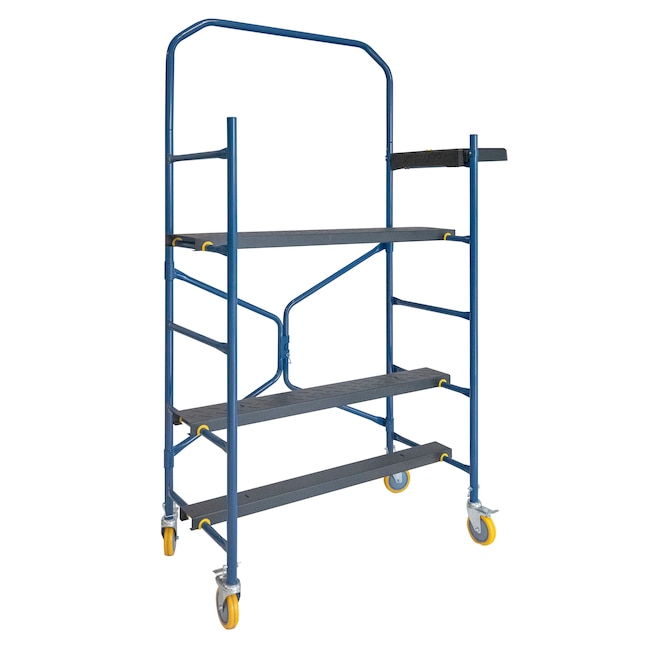Checking Out the Numerous Sorts Of Scaffolding Used in Construction Jobs
The building industry relies greatly on different kinds of scaffolding to meet details job requirements, each offering unique benefits and applications. Standard frame scaffolding supplies a tough foundation for basic jobs, while suspended scaffolding is essential for work on skyscraper structures.

Conventional Framework Scaffolding
Typical structure scaffolding is just one of one of the most extensively utilized approaches in the building and construction sector due to its toughness and versatility. This system contains vertical and horizontal frameworks that are constructed to develop a secure platform for products and workers. The major elements include upright articles, straight ledgers, and angled braces, which together provide a strong framework that can support considerable tons.
Among the crucial advantages of typical frame scaffolding is its versatility to different building jobs, ranging from household buildings to huge commercial structures. The modular design enables very easy assembly and disassembly, making it reliable for both long-term and short-term jobs. Furthermore, the system can be customized in height and size, suiting different structure styles and site problems.
Safety is extremely important in scaffolding applications, and conventional structure systems are geared up with guardrails and toe boards to avoid falls and guarantee worker protection. In addition, routine examinations and adherence to security laws are essential in preserving the stability of the scaffold. On the whole, traditional structure scaffolding stays an essential option in the building and construction industry, offering a trustworthy system for labor and boosting total project efficiency

Suspended Scaffolding
Suspended scaffolding offers an unique remedy for building projects that call for accessibility to raised surfaces, specifically in circumstances where standard frame scaffolding might be unwise. This sort of scaffolding is typically suspended from the roofing or upper levels of a structure, making use of a system of ropes, pulley-blocks, and platforms to produce a functioning area that can be adapted to numerous heights.
Among the primary benefits of suspended scaffolding is its versatility. It can be easily rearranged or decreased to accommodate changes in construction needs, making it suitable for tasks such as window installment, frontage work, and upkeep on skyscrapers. In addition, the minimal impact of suspended scaffolding enables for better usage of ground space in metropolitan settings, where area is usually limited.
Safety is an essential factor to consider in the use of suspended scaffolding. In general, suspended scaffolding provides a efficient and efficient solution for accessing hard-to-reach areas in various construction scenarios, improving both productivity and security on website.
System Scaffolding
System scaffolding, commonly considered as a modern solution in the scaffolding sector, is composed of pre-engineered parts that can be rapidly put together and adapted for different building tasks. Scaffolding. This kind of scaffolding is characterized by its modular layout, which permits for adaptability and efficiency on work websites, suiting architectural needs and different heights
Typically made from high-strength steel or light weight aluminum, system scaffolding uses enhanced sturdiness and stability. The components consist of vertical posts, horizontal ledgers, and diagonal dental braces, Get More Info which adjoin securely, ensuring a durable framework. The design often includes standardized fittings, streamlining assembly and disassembly procedures, thus minimizing labor time and expenses.

Rolling Scaffolding
Moving scaffolding is a flexible choice to typical set scaffolding, developed for wheelchair and ease of use on building sites. This type of scaffolding consists of a platform sustained by structures with wheels, enabling employees to quickly relocate it as required. The mobility feature dramatically improves productivity, as it reduces downtime connected with disassembling and constructing fixed scaffolding.
Generally constructed from light-weight materials such see it here as aluminum or steel, rolling scaffolding offers a tough yet mobile solution for jobs needing frequent repositioning - Scaffolding. It is specifically helpful in jobs such as paint, drywall installation, and electric work, where accessibility to different heights and areas is required
Safety and security is paramount in rolling scaffolding design, with functions such as locking wheels to stop unplanned motion when in operation, and guardrails to shield workers from drops. Additionally, several designs are flexible in height, suiting different project requirements.
Cantilever Scaffolding

The style of cantilever scaffolding generally entails utilizing braces or arms secured to a structure or structure, enabling the platform to extend outward securely. Security is critical; therefore, these scaffolds should be engineered to hold up against numerous tons and environmental conditions. Regular examination and upkeep are necessary to make sure architectural stability and employee security.
Cantilever scaffolding is favored for its adaptability and effective use room, making it a prominent choice in urban settings sites where space restraints prevail. It promotes much easier access to high altitudes, ultimately contributing to the overall performance of building tasks. Just like all scaffolding kinds, appropriate training and adherence to safety and security requirements are critical for workers utilizing cantilever scaffolding.
Final Thought
Traditional frame scaffolding offers stability, while put on hold scaffolding supplies versatility for elevated jobs. System scaffolding assists in fast setting up, and rolling scaffolding boosts flexibility for differing job environments.
Conventional frame scaffolding offers a durable structure for basic jobs, while put on hold scaffolding is necessary for job on skyscraper frameworks.Moving scaffolding is a flexible option to conventional set scaffolding, created for movement and ease of usage on building and construction sites. As with all scaffolding kinds, correct training and adherence to safety and security criteria are vital for employees using cantilever scaffolding.
Typical structure scaffolding gives stability, while suspended scaffolding supplies adaptability for raised jobs. System scaffolding helps with quick setting up, and rolling scaffolding enhances mobility for varying work settings.
Comments on “Professional Scaffolder Surrey: Your Trusted Partner for Safe Installations”